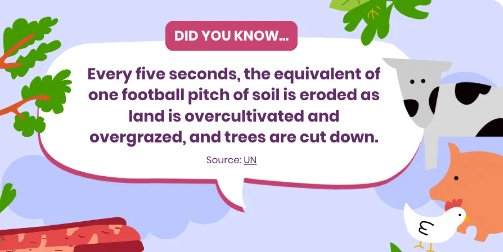What Is Land Degradation?
Land degradation is caused by multiple forces, including extreme weather conditions, particularly drought. It is also caused by human activities that pollute or degrade the quality of soils. Desertification is a form of land degradation by which fertile land becomes desert. It is a global problem that affects everyone through food scarcity, higher food prices, climate migration, and the loss of biodiversity. The main causes are:
- Deforestation around the world, but particularly in rainforests. Agriculture is the key driver of this with cattle grazing, soy for animal feed, and palm oil being responsible for 60% of tropical deforestation.
- Unsustainable agriculture practices such as monocropping (rather than crop rotating), excessive use of chemical fertilisers and pesticides, and overgrazing.
- Climate change makes it all worse as increased temperatures dry and erode the soil, high rainfall washes topsoil away, and sea-levels rise in coastal areas.
Step 1: Land Restoration
Countries around the world are actively engaging in various land restoration efforts to combat environmental degradation and promote sustainability. Initiatives include large-scale reforestation to halt desertification, sustainable agricultural practices to restore soil health and reduce erosion, and conservation programs to protect and rehabilitate natural ecosystems, such as wetlands and mangroves, which are crucial for biodiversity.
The Great Green Wall is one such movement, with the epic ambition to grow an 8,000km natural wonder across the entire width of Africa. A decade in and roughly 15% complete, the initiative is already restoring Africa’s degraded landscapes on an unprecedented scale, providing food security, jobs, and a reason to stay for millions along its path. Taking root in Africa’s Sahel region, at the southern edge of the Sahara Desert, one of the poorest places on the planet, the Great Green Wall is on the frontline of climate change. Persistent droughts, food shortages, conflicts over dwindling natural resources, and mass migration to Europe are some of the devastating consequences faced by locals. Yet, communities from Senegal in the West to Djibouti in the East are fighting back. Once complete, the Great Green Wall will be the largest living structure on the planet, three times the size of the Great Barrier Reef.
Here are 3 steps you can take as an individual:
- Compost your food waste. Finished compost is a natural fertiliser packed with nutrients that improve soil health, structure, and drainage. Making your own compost will save money as you don’t need to buy fertiliser.
- Support local schemes. Community gardens, local parks, urban tree planting and more. They all need your support.
- Choose organic. Organic food is better for biodiversity, better for soil health and avoids artificial fertilisers and pesticides.
STEP 2 : CONTINUED IN NEXT BLOG

